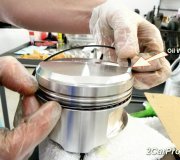That's why I said to not use a lot of pressure on the c-clamp. I never allowed my students to use a c-clamp on any caliper but I suggested it to you because you have an unusual situation. Too many people think c-clamps are necessary and acceptable to retract front pistons. In fact, if you NEED a c-clamp to make the piston move, there is a ring of rust or dirt around the piston or there's debris built up in the caliper. Replacement front calipers are so cheap today we can't even rebuild them cost effectively.
The purpose of the c-clamp in back is not to force the piston against that adjusting screw. That is what will destroy it. If you unbolt the parking brake lever, then turn the adjusting screw with a wrench, that screw is going to screw into the piston. That is what will allow you to push the piston back into the caliper a little at a time. I typically do that by reattaching the caliper to its mount with the rotor in place, then I use a medium flat blade screwdriver to slowly pry the piston back in. That's how I retract all front pistons before I ever take the calipers off. If a piston won't retract on the front, the vehicle gets two rebuilt replacements.
The tool you're using puts just as much pressure on the piston as a c-clamp. Also, those threads they're warning about damaging are what applies the pressure when you apply the parking brake. That pressure is going to be a real lot higher than anything you can do with a clamp. Since you can't fit one in there anyway, use that tool after you thread the screw in a little. That screw will also have to turn counter clockwise if the piston does.
Keep in mind too that Ford had some vans and trucks that had the right parking brake cable run all the way to the rear bumper and come in from the back. Those calipers were different than when the cable comes in from the front like normal.
Monday, April 15th, 2013 AT 12:49 PM



